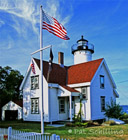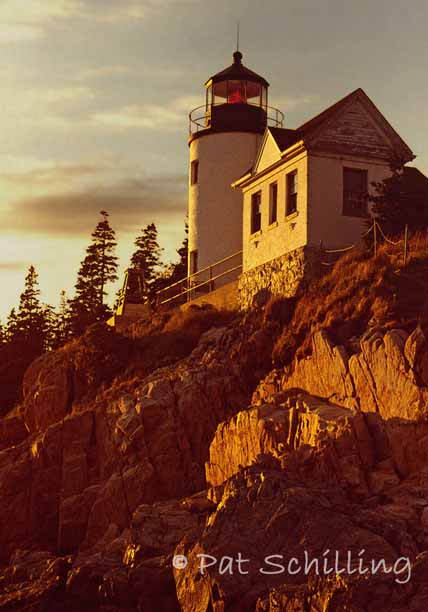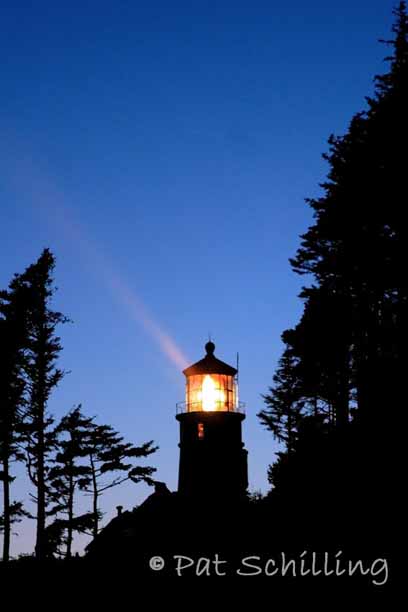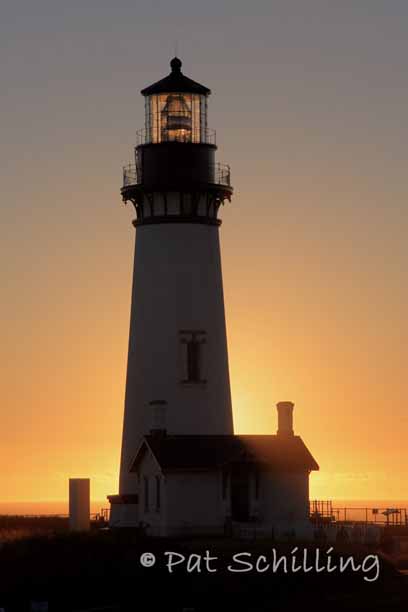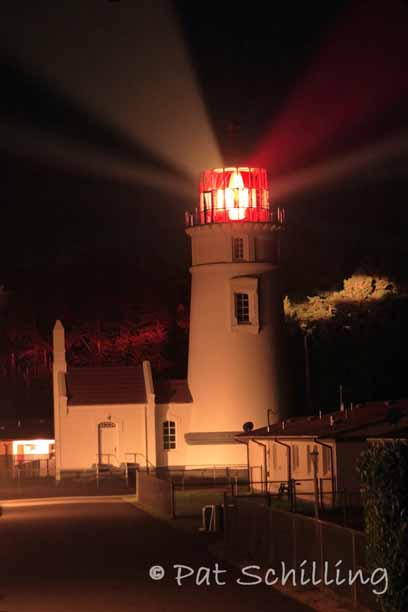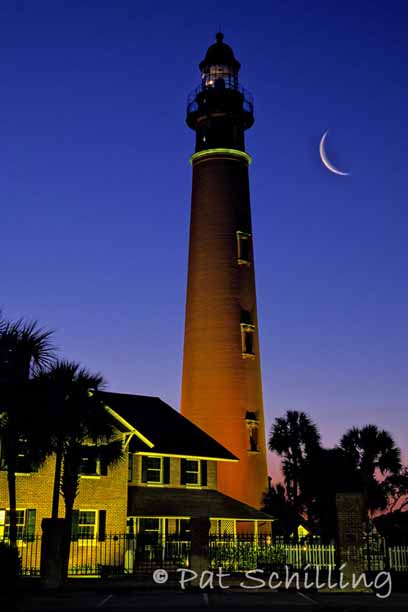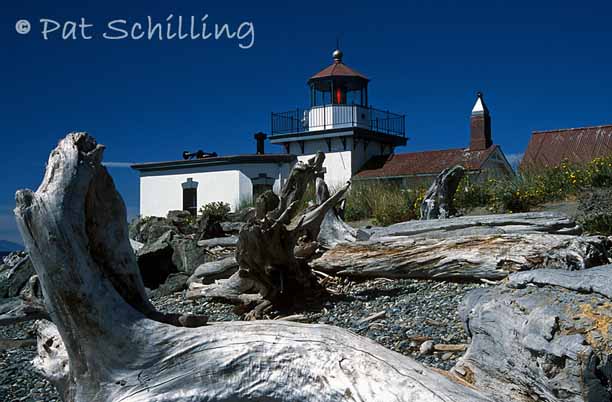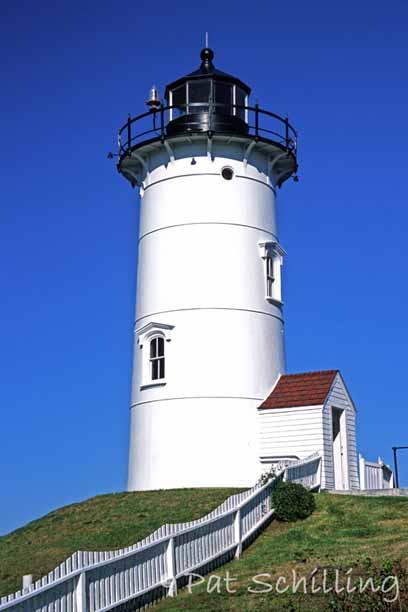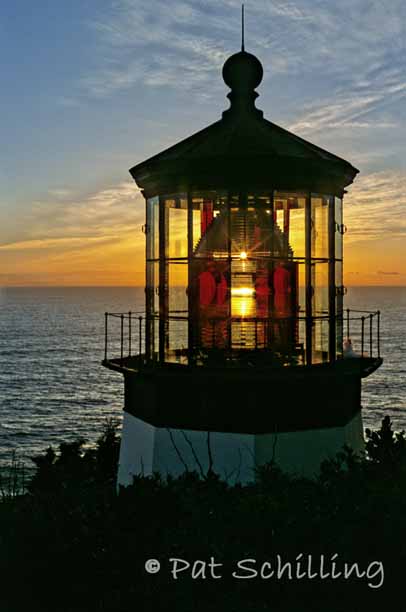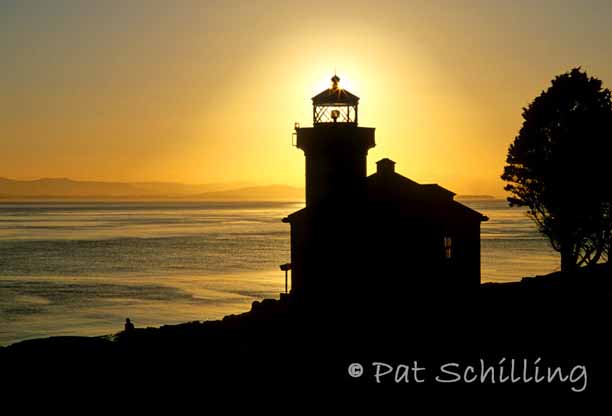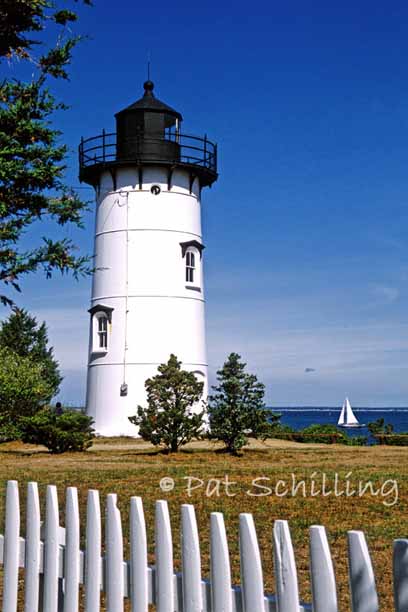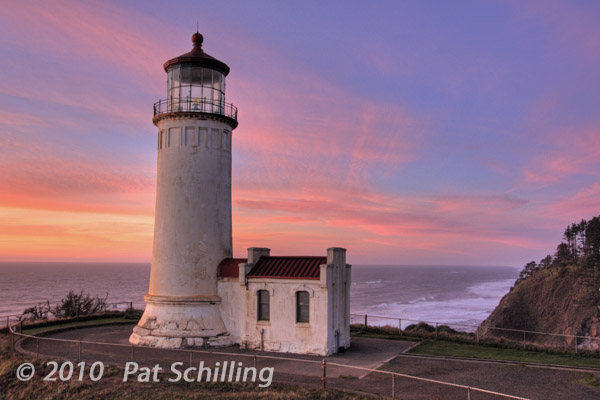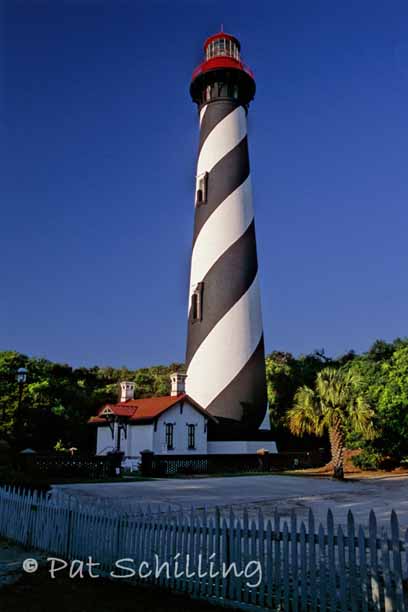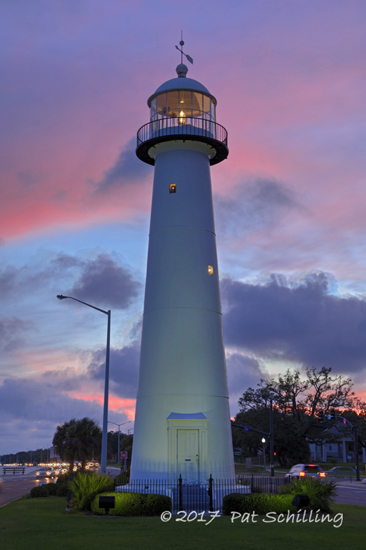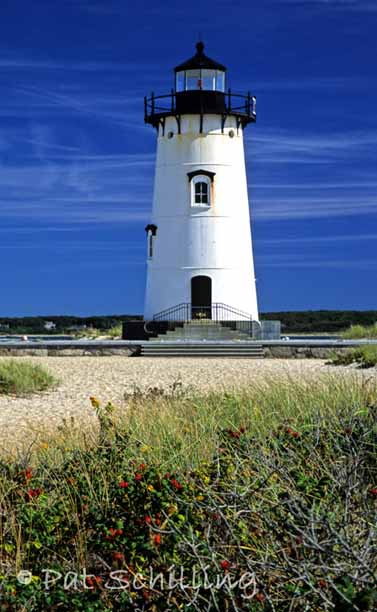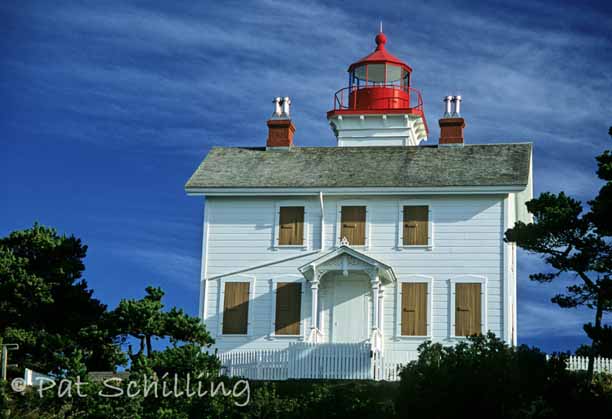The
first lighthouse at this location, was named Mosquito Inlet Lighthouse.
Mosquito Inlet served as the exit point for two rivers: the Halifax
River to the north and the Hillsborough River, later named the Indian
River, to the south. Th lighthouse was a 45-foot, conical, brick tower
and a dwelling, completed in February, 1835. However, during a violent
storm in October, the dwelling was washed into the inlet and the
foundation of the tower was undercut, and the lighthouse eventually
collapsed in April of 1836. A site for the new lighthouse was
selected on the north side of the inlet to prevent the southward moving
inlet from claiming a second tower. Over a million bricks would be used
to construct this lighthouse, which slowly grew to its preordained
height of 175 feet, six-and-a-half inches from the ground to the tip of
the lightning rod. The only taller brick lighthouse in the country is
Cape Hatteras. The tower was lit for the first time on November 1,
1887. Though accurate, the name Mosquito Inlet proved a deterrent to
increased settlement in the area. To correct this problem, in 1927, the
name was officially changed to Ponce de Leon Inlet in honor of the
famed explorer, and the lighthouse became the Ponce de Leon Inlet
Lighthouse. Today, the lighthouse is owned by the Town of Ponce Inlet
and managed by the Ponce de Leon Inlet Lighthouse Preservation
Association. The grounds, dwellings and tower are open. It is said, the
Ponce de Leon Inlet Lighthouse is one of the finest light stations in
the United States. For my first, I
arrived there an hour or so before sunrise, hoping to explore
the area a bit before first light. Imagine my pleasant surprise to find
it illuminated at night....and a nice crescent moon to boot!
|
West
Point Lighthouse
# WA-110
|
Since
West Point Lighthouse started operation on November 15, 1881, it has
guided countless vessels into Seattle's Elliot Bay, located just south
of the point. When the Lake Washington Ship Canal
was completed just north of West Point in 1917, the lighthouse also
served as a marker to the entrance of this liquid link between Puget
Sound and Lake Union and Lake Washington. In 1985, West Point
was
the last light station in Washington State to be automated. The
West Point Lighthouse is now part of Discovery Park, Seattle's largest
city park. It remains an active lightstation.
The
original Nobska Point Lighthouse was in the typical Cape
Cod-style with an octagonal tower atop a keeper’s house,
which had three rooms on the first floor and two small ones upstairs. While
a common lighthouse design, unfortunately, it was a poor one. Time and
the elements quickly took their toll. In
1876, Nobska was rebuilt as a 40-foot, cast-iron
tower lined with brick. A new 1.5-story wood-frame dwelling
was also built. A
covered walkway connecting the tower to the keeper’s house
was added in 1899, and in 1907 a second dwelling was constructed to
house an assistant keeper. Today, the lighthouse is
owned by the Coast Guard. Grounds are open, tower is open during open
houses, and the dwelling is closed.
Sunset
Through The Lens
# OR-126
|
Cape
Meares lighthouse sits at the north end of the beautiful 20-mile Three
Capes Scenic Loop along the Oregon coast. The lighthouse was
built in 1889 and commissioned on January 1, 1890. The tower stands 38
feet high and is the shortest lighthouse in Oregon, although
it's
located on a 217-foot cliff, and can be seen for 21 miles.
The
tower is made of sheet iron lined with bricks, the only one of its kind
on the Oregon coast. The lighthouse is owned by the Coast
Guard
and managed by Oregon State Parks. Grounds are open,and the tower is
open in season. It remains an active light.
Lime Kiln lighthouse is
located on the west side of San Juan Island, the largest island of the
archipelago, and
watches over the whales and waterways of the entrance to Haro Strait. The lighthouse gets its
name from the lime kilns built nearby in the 1860s. Beginning
operations in 1914, it was the last major light established in
Washington.
The lighthouse has a 38-foot octagonal concrete tower rising from the
fog signal building. In
1985, the lighthouse and surrounding sea were dedicated as a whale
sanctuary and research station for marine mammal scientists. The scientists
based in the lighthouse track the movements and behavior of the orca
whales, which reside in the area. The lighthouse is owned by
Washington State Parks. Grounds are open, and the lighthouse
is open during tours.
The conical
cast-iron tower of East Chop Lighthouse, stands 40 feet tall,
and was erected in 1878, along with a one-and-a-half-story keeper's
house. The
lighthouse was painted white at first, but in the 1880s it received a
coat of reddish-brown paint and became popularly known as the
“Chocolate Lighthouse.” In 1934, when the
light was being automated, the keeper's house and oil house were
removed.
In 1988, its daymark was returned back to white, as the dark color was
causing excessive heat and condensation in the tower. East
Chop Lighthouse remains an active aid to navigation.
It is owned by the Coast Guard and managed by the Martha's
Vineyard Historical Society. Grounds are open to the public,
and the tower is open during scheduled tours.
Construction
of North Head Lighthouse began in 1896. It was
lit for the first time on May 16, 1898.
The tower is brick masonry with a cement plaster overlay built on a
sandstone foundation. The
lantern room is 65 feet from the ground and 194 feet above sea. North
Head is one of the windiest places in the United States. On January 29,
1921, winds were clocked at 126 mph before the instrument blew away.
They have frequently been measured at over 100 mph. The
keepers' dwellings, located about a ½ mile into the woods
from the tower have been restored, and both the keepers'
duplex and the single-family dwelling are available for overnight stays. The lighthouse is
owned by the Coast Guard. The grounds are open, and the tower is open
in season.
|
St.
Augustine Light
# FL-102
|
A
Spanish watchtower, built in the late 1500's was the predecessor of the
present St. Augustine Lighthouse. St. Augustine is the site of the
oldest aid to navigation in North America. The original watchtower
became Florida's first lighthouse in 1824. However, by 1870, the tower
was threatened by shoreline erosion and construction began on the
current lighthouse. The new tower was completed in 1874. The St. Augustine
Lighthouse rises 165 feet above sea level and contains 219 steps.
The lighthouse is owned by
the St. Augustine Lighthouse and Museum. Grounds/tower/dwelling open.
This tower is illuminated at night.
Unfortunately, on
my only trip there (so far!), I couldn't work that time frame
into my schedule. Next time!
The first Biloxi
Lighthouse was one of three Mississippi Sound lighthouses authorized in
1847. Metal plates were bolted together to form the
lighthouse, which was strengthened by a brick lining. The
forty-five-foot-tall tower was completed in the spring of 1848. In
1856, a fourth-order Fresnel lens replaced the array of lamps and
reflectors. By 1880, storm damage had taken it's toll, and the
lighthouse was torn down and a new one built. The light was automated
in 1940, and the City of Biloxi acquired the light station the
following year. Storm damage through the years again left the tower in
a state of disrepair. In 2009 to early 2010, the lighthouse underwent
$400,00 of renovation and repair.
Edgartown
Lighthouse 2
# MA-104
|
The
first lighthouse
was a two-story wooden house with a lantern on the roof, built in 1828.
The house had three rooms on the first floor and two on the
second. The lighthouse sat offshore on pilings, meaning the
keeper originally had to row a short distance to reach the mainland.
In 1830, a wooden causeway was built to the lighthouse.
As
with so many wooden lighthouses, the elements began taking their toll.
The dwelling and walkway were
continually repaired through the years. The
hurricane
of September 21, 1938, pretty much finished off the old building.
In 1939, under the direction of the Coast Guard, the 1881
45-foot
cast-iron tower from Crane's Beach in Ipswich was disassembled
and
brought by barge to Edgartown. Over the decades, sand
gradually
filled in the area between the lighthouse and the mainland, so that
today Edgartown Light is on a beach.
The
lighthouse is still owned by the Coast Guard and managed by the
Martha's Vineyard Historical Society. Grounds open, tower
open in
season.
The
two areas of land known as West Chop and East Chop define the harbor at
Vineyard Haven, on the north shore of Martha’s Vineyard.
Vineyard
Haven was formerly known as Holmes Hole and was one of the earliest
settlements on the island. The first lighthouse at West Chiop was a
25-foot rubble stone tower and an accompanying stone dwelling measuring
twenty by thirty-four feet and went into service on October 5, 1817.
The location proved problematic, with the sea began encroaching within
a short short time. A new conical stone tower and keeper’s
house
were built in 1846 about 1,000 feet southeast of the original
tower. By the 1890s, West Chop had become a popular and
fashionable summer vacation spot, and the houses that had sprung up in
the area were beginning to obscure the lighthouse beacon. To remedy
this, a 45-foot cylindrical tower, was constructed in 1891 to replace
the shorter 1847 tower. This new redbrick tower was painted white in
1899. West Chop remains an active light station. The lighthouse is
owned by the Coast Guard. Grounds/dwelling/tower closed. But
because the grounds cover a fairly small area, pictures are easily
captured.
Yaquina
Bay Light
# OR-125
|
The
Yaquina Bay Lighthouse, a charming two-story clapboard structure, is
located on a hill overlooking the northern side of the entrance to
Yaquina Bay, just north of Newport, OR.
Its beacon shown for the first time on November 3, 1871.
However,
with increased maritime traffic along the Oregon Coast, the Lighthouse
Board decided the area would be better served with a coastal light at
Yaquina Head, just four miles to the north. The completion of Yaquina
Head Light in 1873 eliminated the need for the Yaquina Bay Lighthouse.
On October 1, 1874, Yaquina bay's light was extinguished. For most of
the next almost 100 years, the lighthouse remained vacant. In
1974, the old deserted and dilapidated lighthouse was restored under
the Historical Preservation Program, and later accepted on the National
Register of Historic Places. The Lincoln County Historical Society
conferred the lighthouse to the Oregon State Parks Department. On
December 7, 1996, the light was re-lit. The light is an official U.S.
Coast Guard privately maintained aid to navigation displaying a fixed
white light visible for six miles.
The lighthouse is owned by
Oregon State Parks and managed by Friends of Yaquina Lighthouses.
Grounds/dwelling/tower open.















